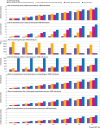Colorectal cancer screening with faecal immunochemical testing, sigmoidoscopy or colonoscopy: a microsimulation modelling study
- PMID: 31578177
- PMCID: PMC6774435
- DOI: 10.1136/bmj.l5383
Colorectal cancer screening with faecal immunochemical testing, sigmoidoscopy or colonoscopy: a microsimulation modelling study
Abstract
Objective: To estimate benefits and harms of different colorectal cancer screening strategies, stratified by (baseline) 15-year colorectal cancer risk.
Design: Microsimulation modelling study using MIcrosimulation SCreening ANalysis-Colon (MISCAN-Colon).
Setting: A parallel guideline committee (BMJ Rapid Recommendations) defined the time frame and screening interventions, including selection of outcome measures.
Population: Norwegian men and women aged 50-79 years with varying 15-year colorectal cancer risk (1-7%).
Comparisons: Four screening strategies were compared with no screening: biennial or annual faecal immunochemical test (FIT) or single sigmoidoscopy or colonoscopy at 100% adherence.
Main outcome measures: Colorectal cancer mortality and incidence, burdens, and harms over 15 years of follow-up. The certainty of the evidence was assessed using the GRADE approach.
Results: Over 15 years of follow-up, screening individuals aged 50-79 at 3% risk of colorectal cancer with annual FIT or single colonoscopy reduced colorectal cancer mortality by 6 per 1000 individuals. Single sigmoidoscopy and biennial FIT reduced it by 5 per 1000 individuals. Colonoscopy, sigmoidoscopy, and annual FIT reduced colorectal cancer incidence by 10, 8, and 4 per 1000 individuals, respectively. The estimated incidence reduction for biennial FIT was 1 per 1000 individuals. Serious harms were estimated to be between 3 per 1000 (biennial FIT) and 5 per 1000 individuals (colonoscopy); harms increased with older age. The absolute benefits of screening increased with increasing colorectal cancer risk, while harms were less affected by baseline risk. Results were sensitive to the setting defined by the guideline panel. Because of uncertainty associated with modelling assumptions, we applied a GRADE rating of low certainty evidence to all estimates.
Conclusions: Over a 15 year period, all screening strategies may reduce colorectal cancer mortality to a similar extent. Colonoscopy and sigmoidoscopy may also reduce colorectal cancer incidence, while FIT shows a smaller incidence reduction. Harms are rare and of similar magnitude for all screening strategies.
Published by the BMJ Publishing Group Limited. For permission to use (where not already granted under a licence) please go to http://group.bmj.com/group/rights-licensing/permissions.
Conflict of interest statement
Competing interests: All authors have completed the ICMJE uniform disclosure form and declare no support from any organisation for the submitted work. GG is a member of the GRADE working group. ILV has received funding for monitoring, evaluation and cost effectiveness analysis of different colorectal cancer screening strategies, from the US National Cancer Institute, European Commission, ZonMw, The Dutch Cancer Society, Netherlands Institute of Public Health, and NHMRC Australia. Her institution has received payments for her lectures and educational events on colorectal cancer screening for Erasmus MC and Utrecht Medical Center. She has contributed in writing a guidebook on colorectal cancer screening for the International Agency for Research in Cancer (IARC) and has received travel expenses and per diem from IARC. She has not directly contributed to other guidelines, but her work has served as input to the deliberations of other guideline-issuing committees such as USPSTF and ACS. MBr is an author on the NORCCAP trial, one of the trigger trials of this guideline with long term follow-up of sigmoidoscopy screening. He is the principal investigator on the ongoing Nordicc trial comparing no screening with colonoscopy screening. No results have been published from this study yet. He has taken part in writing a guidebook on colorectal cancer screening for the IARC 2017-18. There are no other relationships or activities that could appear to have influenced the submitted work.
Figures

References
MeSH terms
LinkOut - more resources
Full Text Sources
Other Literature Sources
Medical
